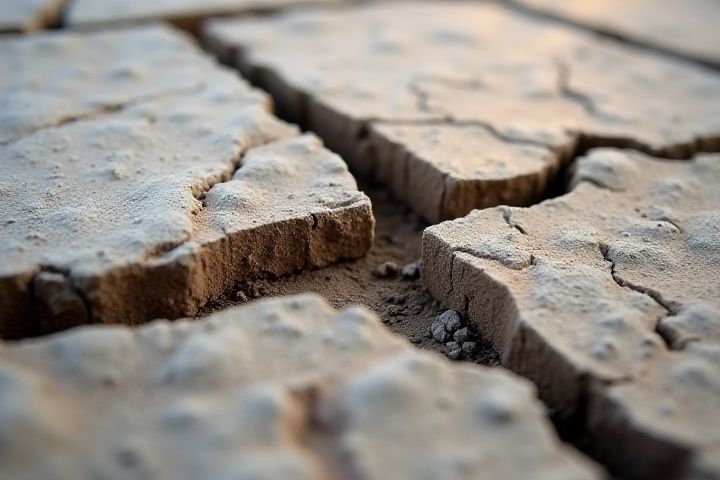
House foundation cracks typically occur due to soil movement, inadequate drainage, or temperature fluctuations. When soil expands and contracts due to moisture changes, it can exert pressure on the foundation, leading to cracks. Poor drainage around the home can cause water to pool near the foundation, weakening the soil and resulting in settlement issues. Over time, these factors combined with seasonal temperature shifts can exacerbate existing vulnerabilities in the foundation material. Regular maintenance and monitoring can help you identify potential issues early, safeguarding your home's structural integrity.
Why House Foundation Cracks
Soil Movement
House foundation cracks primarily occur due to soil movement, which can result from various factors, including moisture fluctuations, soil expansion, and contraction. When the soil beneath your foundation absorbs water, it can swell, lifting the foundation and causing stress on the structure. Conversely, in dry conditions, the soil can shrink, leading to settling and creating uneven pressure on the foundation. Understanding these soil dynamics is crucial for homeowners, as addressing soil issues early can prevent costly foundation repairs and ensure the integrity of your home.
Poor Drainage
Poor drainage is a primary cause of house foundation cracks, often leading to significant structural damage. When soil around the foundation remains saturated due to inadequate drainage, it can expand and exert pressure on the foundation, resulting in cracks. Approximately 40% of foundation issues stem from water-related problems, underscoring the importance of effective drainage systems. Implementing solutions such as gutters, downspouts, and proper grading can significantly alleviate excess moisture and protect your home's foundation.
Tree Root Growth
Tree root growth can exert significant pressure on house foundations, leading to cracks and structural damage. In fact, roots can grow several feet wide and deep, often reaching up to 20 feet or more in search of moisture and nutrients. As these roots invade the soil around the foundation, they can displace and weaken the soil, creating instability. Monitoring the proximity of large trees, particularly those with aggressive root systems, can help mitigate foundation issues and protect your property.
Earthquake Activity
House foundation cracks can often be attributed to earthquake activity, especially in regions prone to seismic events. The ground movement during an earthquake exerts significant stress on structures, leading to shifts in soil and foundation displacement. Research indicates that even minor quakes can generate cracks, with damage occurring in up to 20% of homes in active fault zones. To protect your investment, it's essential to regularly inspect your foundation and consider retrofitting if you live in an earthquake-prone area.
Poor Construction Techniques
Poor construction techniques can lead to significant issues in house foundations, including cracking. For instance, inadequate mixing of concrete may result in weaker structures, allowing for greater susceptibility to shifting soil and environmental pressures. A study found that approximately 30% of foundation problems stem from improper drainage systems that fail to divert water away from the home. If your foundation has cracks, it is crucial to assess the construction methods used, as these flaws can compromise the integrity of your entire home.
Natural Settling
Natural settling occurs as soil beneath a house shifts and compresses over time, affecting the foundation's stability. Factors such as moisture content, soil type, and the weight of the structure contribute to this process, leading to inevitable foundation cracks. When the soil expands or contracts due to changes in rainfall or temperature, it exerts pressure on your home's foundation, resulting in visible fractures. Understanding this phenomenon can help you identify potential issues early and address them proactively, ensuring the integrity of your property's foundation.
Extreme Weather Conditions
Extreme weather conditions, such as prolonged droughts and heavy rainfall, can significantly impact house foundations, leading to cracks. Soil shrinkage during droughts causes foundations to sink, while excessive moisture during heavy rains can lead to swelling and heaving, both of which create stress on the foundation structure. According to the National Association of Home Builders, over 90% of foundation issues are related to poor drainage, exacerbated by these weather fluctuations. Monitoring your home's foundation regularly can prevent costly repairs, as early detection of cracks is crucial for maintaining structural integrity.
Plumbing Leaks
House foundation cracks often stem from plumbing leaks, which can lead to soil erosion and uneven settling. When water seeps into the ground around a foundation due to a leak, it can create voids that compromise structural integrity, resulting in cracks. Detecting plumbing leaks early is crucial; over 14% of homes experience significant moisture issues that can exacerbate foundation problems. Regular inspections and maintenance of plumbing systems can help you prevent costly repairs and ensure the stability of your home's foundation.
Overloading
Overloading is a critical factor contributing to house foundation cracks, as excessive weight can stress the foundation beyond its design limits. This situation often arises from factors such as heavy furniture, added structures, or even water accumulation from poor drainage, leading to uneven weight distribution. When the load exceeds the foundation's capacity, it may result in visible cracks, typically appearing in the form of vertical or horizontal fissures. Monitoring the weight placed on your foundation and ensuring proper drainage can help mitigate the risk of structural damage.
Temperature Fluctuations
Temperature fluctuations, which can vary significantly between seasons, are a primary factor in the cracking of house foundations. When temperatures rise, materials like concrete expand; conversely, during colder months, they contract. This constant cycle of expansion and contraction creates stress within the foundation, often leading to cracks. In regions experiencing temperature swings of 30degF or more, homeowners should monitor their foundations for signs of damage and consider preventive measures.
